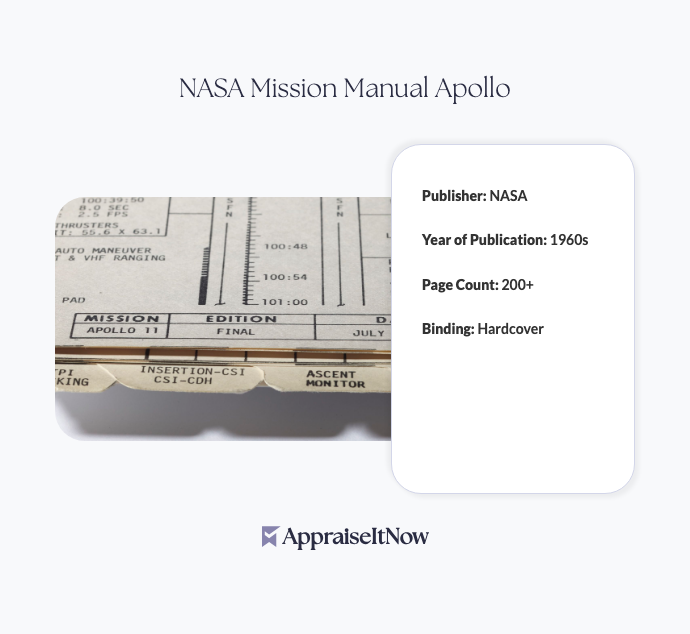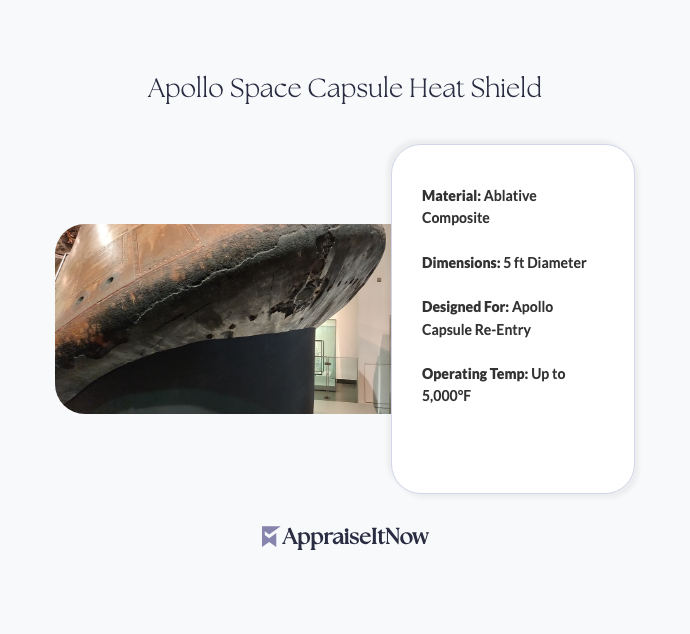<h1>How to Get Your NASA Mission Manual Apollo Appraised</h1>
<p>The NASA Mission Manual Apollo represents one of the most significant pieces of space exploration history, commanding collector interest and strong market value. If you're considering selling, insuring, or simply verifying the worth of this remarkable document, understanding what drives its <strong>$3,000 to $5,000</strong> valuation helps you make informed decisions about one of the most sought-after aerospace collectibles.</p>
<h2>Why NASA Mission Manual Apollo Commands Premium Prices</h2>
<p>Your NASA Mission Manual Apollo holds substantial value because it captures humanity's greatest achievement—the Apollo program—in meticulous, technical detail. First published in the 1960s when space exploration captivated the global imagination, these manuals were produced in <strong>limited quantities of approximately 500 copies worldwide</strong>, making them extraordinarily rare today. The manual's historical significance transcends typical <a href="/types/memorabilia-and-collectibles">memorabilia and collectibles</a>; it represents the engineering blueprint that enabled mankind's first steps on the Moon.</p>
<p>The distinction between a standard aerospace document and your NASA Mission Manual Apollo lies in its authenticity, rarity, and the tangible connection it provides to one of humanity's defining moments. Unlike reproductions or later publications, original 1960s Apollo manuals contain the precise technical specifications, mission protocols, and first-hand accounts from astronauts who literally ventured into the unknown. This provenance creates strong demand among space enthusiasts, institutional collectors, aerospace historians, and individuals building serious collections of space-age memorabilia.</p>
<div class="callout tip"><p><strong>Collector's Insight</strong></p>
<p>NASA Mission Manual Apollo copies signed by multiple astronauts can command 30-50% premiums over unsigned examples, as authentication from lunar pioneers adds immeasurable value.</p></div>
<h2>Key Characteristics That Define Your Apollo Manual's Value</h2>
<p>When evaluating your NASA Mission Manual Apollo for appraisal purposes, several physical and historical factors directly influence its market worth. Understanding these elements helps you appreciate why professional appraisers treat space exploration documents with such careful attention.</p>
<p>The manual's construction quality immediately distinguishes it as a premium publication. Printed on high-quality paper—unusual for technical military documents of that era—your Apollo manual resists degradation better than many contemporaneous publications. The inclusion of detailed diagrams and intricate illustrations transforms it from mere text into a visual historical record that aerospace engineers, museum curators, and serious collectors actively seek.</p>
<p>Authentication markers significantly impact valuation. Original 1960s printings contain specific manufacturer identifications, printing dates, and technical notations that reproductions cannot accurately replicate. The presence of astronaut signatures elevates value substantially; these handwritten endorsements from the men who walked the Moon create direct, irreplaceable connections to Apollo history. Serial numbers or limited edition notations further authenticate scarcity claims that support pricing in the $3,000-$5,000 range.</p>
<h2>Understanding the Apollo Program's Enduring Market Appeal</h2>
<p>Your NASA Mission Manual Apollo derives value not just from rarity, but from the profound cultural significance attached to the Apollo missions themselves. The space race captivated humanity during the 1960s and 1970s, and artifacts from this era—particularly items directly involved in mission success—command sustained collector interest across decades. When considering questions about <a href="/blog/how-to-accurately-determine-the-value-of-your-memorabilia-and-collectibles">how much the Apollo program cost</a>, the answer (approximately $280 billion in today's dollars) underscores the monumental investment that makes original mission documentation invaluable.</p>
<p>These manuals served as operational blueprints for the engineers, flight directors, and mission specialists who orchestrated humanity's lunar expeditions. They contain the actual protocols followed during missions, making them not merely commemorative items but functional historical documents that directly influenced Apollo program success. This dual significance—both cultural artifact and technical blueprint—distinguishes your manual from standard space memorabilia and supports premium valuations.</p>
<p>The question about how many Apollo astronauts remain alive adds another layer of market dynamics. As the pioneering generation of lunar explorers advances in age, authentic artifacts signed by these heroes gain increasing cultural and monetary value. Your NASA Mission Manual Apollo, particularly if it bears signatures, represents a tangible, permanent link to living history that becomes increasingly precious.</p>
<div class="callout note"><p><strong>Historical Context</strong></p>
<p>Of the 12 men who walked on the Moon between 1969 and 1972, fewer than half remain alive today. This scarcity has elevated the value of authentic Apollo-era artifacts bearing astronaut authentication.</p></div>
<h2>Condition Factors Affecting Your Manual's Appraisal</h2>
<p>Professional appraisers specializing in <a href="/types/memorabilia-and-collectibles">space-related collectibles</a> evaluate your NASA Mission Manual Apollo using standardized condition assessment criteria that directly correlate to market value.</p>
<p>Original binding integrity represents a critical factor. Manuals with intact dust jackets, secure spine binding, and minimal page damage command top valuations within the $4,000-$5,000 range. Pages showing foxing (age-related browning) or minor edge wear fall into the $3,000-$4,000 range, while significant deterioration or binding repair drops values toward the $2,000-$3,000 threshold. The quality of any astronaut signatures matters equally—clear, unsmudged endorsements on clean pages add substantial premiums compared to faded or compromised signatures.</p>
<p>Storage history profoundly impacts condition. Manuals protected in climate-controlled environments, away from direct sunlight and moisture, maintain superior condition and higher valuations. If your Apollo manual shows signs of water damage, smoke exposure, or severe fading, professional restoration appraisals might be warranted—though any restoration should be documented and disclosed, as it typically reduces pure collectibility value despite improving physical appearance.</p>
<h2>Documentation and Provenance Considerations</h2>
<p>Your NASA Mission Manual Apollo's provenance—its ownership and exhibition history—significantly influences its appraised value. Manuals with documented histories, particularly those previously owned by aerospace professionals, NASA employees, or displayed in institutional collections, often command premiums. This parallels how <a href="/blog/getting-started-with-antique-furniture-appraisal">antique furniture appraisals</a> value provenance, recognizing that established ownership histories validate authenticity and cultural significance.</p>
<p>If your manual includes signatures, expert authentication becomes essential. Certified handwriting analysis from specialists in astronaut autographs provides documentation that appraisers require when valuing signed examples. The difference between authenticated signatures and unverified marks can mean $1,000 or more in appraised value, making this verification step crucial for accurate assessment.</p>
<div class="callout tip"><p><strong>Authentication Tip</strong></p>
<p>Obtain certificate of authenticity from recognized experts if your manual bears astronaut signatures. This documentation becomes essential for insurance, sale, or institutional donation purposes.</p></div>
<h2>Market Dynamics and Investment Perspective</h2>
<p>The NASA Mission Manual Apollo market has experienced steady appreciation, reflecting broader trends in space-age collectibles and historical memorabilia. As the 50th, 60th, and approaching 70th anniversaries of Apollo missions generate renewed cultural interest, collector demand for authentic contemporary documents remains strong. Museums, aerospace corporations, and wealthy collectors actively seek original materials, creating competitive bidding that supports valuations in the $3,000-$5,000 range for quality examples.</p>
<p>Unlike some collectibles that fluctuate with passing trends, space exploration artifacts maintain relatively stable value because they represent permanent historical significance. The Apollo program will never happen again; it uniquely defined human achievement during a specific era. This immutability creates value stability that appeals to serious collectors and institutional buyers seeking reliable investments in historical authenticity.</p>
<p>Consider how your NASA Mission Manual Apollo compares to other aerospace collectibles. Original astronaut-flown items (suits, patches, instruments) command significantly higher prices—often $10,000 to $100,000—making your manual an accessible entry point for serious space collectors building comprehensive collections. For those exploring broader historical <a href="/blog/appraising-artifacts-and-antiquities-evaluating-historical-finds">artifact appraisals</a>, space-related items consistently rank among the most sought-after categories.</p>
<h2>When Professional Appraisals Become Essential</h2>
<p>You should seek professional appraisal services for your NASA Mission Manual Apollo in several specific situations. If you're planning to sell through auction houses, dealer networks, or private sales, certified appraisals establish credible market values that justify asking prices. Insurance companies typically require professional valuations for items exceeding $2,500, making appraisals necessary for proper coverage of your collection. Estate planning scenarios, where your manual might transfer to heirs or institutions, demand documented valuations for tax and distribution purposes.</p>
<p>Professional appraisers bring expertise that transcends simple price estimation. They authenticate signatures, assess condition using standardized criteria, research comparative sales data, and produce USPAP-compliant reports acceptable to insurance companies, financial institutions, and auction houses. This certification protects you whether you're buying, selling, or protecting your investment through adequate insurance coverage.</p>
<p>AppraiseItNow connects you with credentialed experts across the United States—including AAA, ISA, ASA, CAGA, and AMEA certified appraisers—who specialize in space exploration memorabilia and historical documents. You can submit photographs, descriptions, and provenance documentation securely online and receive certified valuations that reflect current market conditions and your specific item's characteristics.</p>
<div class="callout note"><p><strong>Key Takeaway</strong></p>
<p>Your NASA Mission Manual Apollo represents a valuable piece of space history worth $3,000-$5,000 that deserves professional appraisal documentation. Whether you're selling, insuring, or building a historical collection, certified appraisals provide the expertise, authentication, and documentation necessary to maximize value and ensure your investment receives proper protection and recognition.</p></div>







.avif)







